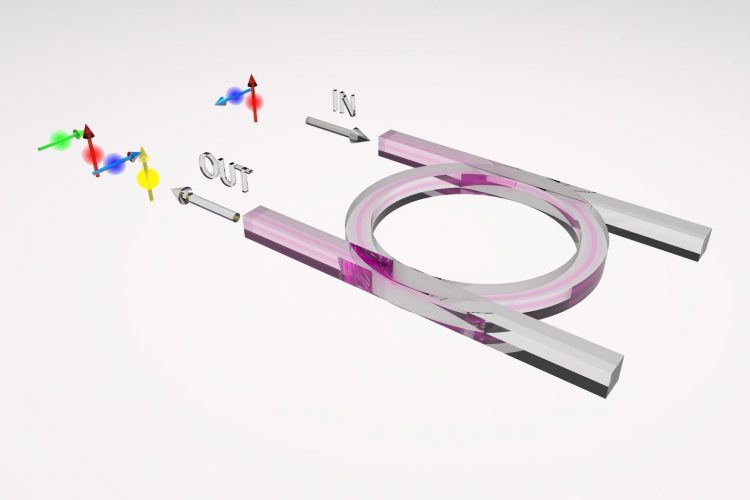A new approach to on-chip quantum computing

Cross-polarized pump photons (red and blue) interact in the micro-ring resonator to directly generate cross-polarized correlated photons (green and yellow). Credit: Lucia Caspani
Commercial devices capable of encrypting information in unbreakable codes exist today, thanks to recent quantum optics advances, especially the generation of photon pairs—tiny entangled particles of light.
Now, an international team of researchers led by professor Roberto Morandotti of INRS-EMT in Canada, is introducing a new method to achieve a different type of photon pair source that fits into the tiny space of a computer chip.
The team's method, which generates “mixed up” photon pairs from devices that are less than one square millimeter in area, could form the core of the next-generation of quantum optical communication and computing technology. The research will be presented at The Optical Society's (OSA) 98th Annual Meeting, Frontiers in Optics, being held Oct. 19-23 in Tucson, Arizona, USA.
One of the properties of light exploited within quantum optics is “photon polarization,” which is essentially the direction in which the electric field associated with the photon oscillates. The research team set out to find a way to directly “mix up,” or cross-polarize, the photons via a nonlinear optical process on a chip.
“While several efforts have been devoted to develop on-chip sources of polarization-entangled photons, the process typically used to generate these photons only allows the generation of photons with the same polarization as the laser beam used to pump the device — either both horizontal or vertical — after which entanglement can be achieved by accurately mixing these states. Now, we have found a way to directly generate cross-polarized photon pairs,” says Lucia Caspani, a postdoctoral fellow at INRS-EMT and co-author of the Frontiers in Optics paper.
To generate the cross-polarized photons, Caspani and colleagues used two different laser beams at different wavelengths —one vertically polarized and another horizontally polarized. The approach, however, came with a potential pitfall: the classical process between the two pump beams could destroy the photons' fragile quantum state.
To address this challenge, the team, which also includes researchers from RMIT University in Australia and City University of Hong Kong, pioneered a new approach based on a micro-ring resonator—a tiny optical cavity with a diameter on the order of tens to hundreds of micrometers—that operates in such a way that energy conservation constraints suppress classical effects while amplifying quantum processes.
While a similar suppression of classical effects has been observed in gas vapors and complex micro-structured fibers, this is the first time it has been reported on a chip, thus opening a clear route for building scalable integrated devices.
“Our approach opens the door to directly mixing different polarizations on a chip,” Caspani points out. “At very low power, our device directly generates photon pairs with orthogonal polarizations, which can be exploited for quantum communication and computing protocols.”
The fabrication process of the chip is also compatible with that currently used for electronic chips. “It enables a future coexistence of our device with standard integrated circuits,” says Caspani, which is a fundamental requirement for the widespread adoption of optical quantum technologies.
Presentation FTu2A.2, “Direct Generation of Orthogonally Polarized Photon Pairs via Spontaneous Non-Degenerate FWM on a Chip,” takes place Tuesday, Oct. 21 at 11 a.m. MST at the Arizona Ballroom, Salon 8 at the JW Marriott Tucson Starr Pass Resort in Tucson.
PRESS REGISTRATION: A press room for credentialed press and analysts will be located in the Marriott, Sunday through Thursday, Oct. 19-23. Those interested in obtaining a press badge for FiO should contact OSA's Lyndsay Meyer at 202.416.1435 or lmeyer@osa.org.
About FiO/LS
Frontiers in Optics (FiO) 2014 is The Optical Society's (OSA) 98th Annual Meeting and is being held together with Laser Science, the 30th annual meeting of the American Physical Society (APS) Division of Laser Science (DLS). The two meetings unite the OSA and APS communities for five days of quality, cutting-edge presentations, fascinating invited speakers and a variety of special events spanning a broad range of topics in optics and photonics—the science of light—across the disciplines of physics, biology and chemistry. An exhibit floor featuring leading optics companies will further enhance the meeting. More information at http://www.FrontiersinOptics.org.
Media Contact
All latest news from the category: Physics and Astronomy
This area deals with the fundamental laws and building blocks of nature and how they interact, the properties and the behavior of matter, and research into space and time and their structures.
innovations-report provides in-depth reports and articles on subjects such as astrophysics, laser technologies, nuclear, quantum, particle and solid-state physics, nanotechnologies, planetary research and findings (Mars, Venus) and developments related to the Hubble Telescope.
Newest articles

Superradiant atoms could push the boundaries of how precisely time can be measured
Superradiant atoms can help us measure time more precisely than ever. In a new study, researchers from the University of Copenhagen present a new method for measuring the time interval,…

Ion thermoelectric conversion devices for near room temperature
The electrode sheet of the thermoelectric device consists of ionic hydrogel, which is sandwiched between the electrodes to form, and the Prussian blue on the electrode undergoes a redox reaction…

Zap Energy achieves 37-million-degree temperatures in a compact device
New publication reports record electron temperatures for a small-scale, sheared-flow-stabilized Z-pinch fusion device. In the nine decades since humans first produced fusion reactions, only a few fusion technologies have demonstrated…





















